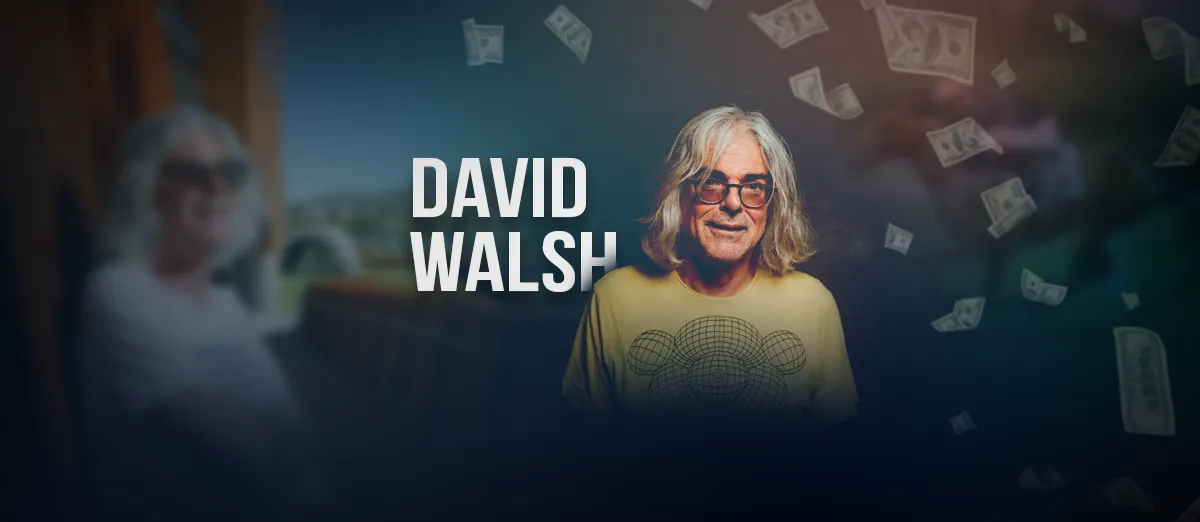David Walsh - The Art Collector Who Robbed the Bookies Using Math

David Walsh (art collector) is an enigmatic figure whose journey from a humble university student in Hobart to a global gambling powerhouse sounds like a fairy tale.
- In this article
- Highlights
- Beginnings
- Career
- David Walsh Net Worth
- Where Is He Today?
- FAQ
Walsh mastered the art of professional gambling and made a name for himself as a renowned art collector and shrewd businessman.
The influence of David Walsh's ventures, such as the iconic Museum of Old and New Art (MONA) and Moorilla Estate, on the world of art and gambling is nothing short of profound, becoming not only one of the most famous gamblers of his generation, but leaving a mark on multiple industries at the same time.
But what truly sets him apart in the high-stakes world of professional gambling? Alongside his longtime friend Zeljko Ranogajec, Walsh has spearheaded one of the largest and most successful betting syndicates globally, handling billions of dollars annually.
One of the most exciting chapters in his life was in 2009 when he made international headlines with his bold gamble on the life of French artist Christina Boltanski.
David Walsh's unconventional approach to gambling, as demonstrated in his mesmerizing gamble on the life Christina Boltanski, and his deep engagement with the art world are sources of inspiration, showcasing his unique perspective and passion.
As we delve deeper into his life, one can’t help but wonder about the secrets behind his impressive empire and the true extent of the David Walsh net worth. Stay with us as we explore the life of a man who is not only one of the world's richest gamblers but a vivid art collector as well.
David Walsh Highlights

- One of the richest gamblers in the world
- Created betting software to predict winners of horse races
- Won $11 million from a single bet on the Melbourne Cup in 2011
- Honored as an Officer of the Order of Australia (AO) in 2016
- Owner of Australia’s largest private museum
Childhood and Adolescence of David Walsh
David Dominic Walsh, born in Hobart, Australia, in 1961, had a modest and intriguing start to life. His early years were marked by health challenges as he battled with asthma.
However, these difficulties only fueled his curiosity and love for books, providing a foundation for the extraordinary ventures that would later define his life.
Despite common misconceptions, Walsh was not born into poverty but was a sickly, asthmatic child who found solace and escape in the vast world of books.
From a young age, Walsh demonstrated an appetite for knowledge, influenced by gifts he received: an astronomy book from his sister, Lindy Lou, and a collection of Isaac Asimov stories from his mother.
His school years at Dominic, a working-class Catholic school, were challenging. Walsh’s shyness and intellectual inclination did little to ease his time in an environment where such traits were undervalued.
His interest in religious studies led to conflicts with a teacher, culminating in Walsh being sent out into the cold Tasmanian winters. However, this also allowed him more time in his sanctuary - the school library - where he continued to expand his intellectual horizons.
During his teenage years, after his sibling moved out, Walsh and his mother relocated to a sunlit flat in a notorious public housing complex. Despite its reputation, Walsh found beauty in their home, surrounded by books, music, and the first color TV his family-owned.
His proximity to the State Library of Tasmania and the Tasmanian Museum and Art Gallery facilitated his self-directed education. He spent countless hours among historical and cultural exhibits, which fueled his curiosity and sense of wonder.
David Walsh’s First Endeavors into Blackjack
At Hobart University, David Walsh’s path took a significant turn when he crossed paths with Zeljko Ranogajec.
This meeting would mark the beginning of a partnership that would shape their futures, leading them on a gambling journey that would evolve into a betting syndicate with an annual handle of billions of dollars.
David Walsh’s professional gambling career took off in the most unusual place, a Physics Club. Here, inspired by card counting strategies discussed by peers, Walsh saw potential in their modest casino wins.
Initially hesitant to take significant risks, his peers watched as Walsh ventured into high-stakes gambling at the nearby Wrest Point Hotel Casino, Australia’s first legal casino.
Walsh’s bold approach caught the attention of Zeljko Ranogajec, a fellow student with a severe knack for gambling. Together, they shifted from casual gambling to a disciplined, strategic pursuit.
Their partnership flourished, bumped the Zeljko Ranogajec net worth by mixing his methodical strategies with Walsh’s audacious bets. This synergy soon turned their initial stakes into a substantial bankroll.
In 1986, the duo tackled Las Vegas, facing an initial setback but gaining invaluable insights.
Using his love for computer programming, Walsh immersed himself in gambling literature at the University of Nevada.
This deep dive into gambling systems and psychology catalyzed his next venture—developing betting software for horse racing.
Walsh’s Successful Career and Partnership Ranogajec
In 1987, Walsh and Ranogajec collaborated on a journey that would once again change the course of their careers.
They moved to Sydney, marking the occasion with their first victorious bet on a horse race using Walsh’s betting program. Although this initial success hinted at a promising future, the road ahead was fraught with challenges.
Their focus shifted primarily to thoroughbred racing, yet their financial success was inconsistent despite their sophisticated systems and strategies.
They faced periods of near financial collapse, relying on skilled blackjack play to stay afloat. Walsh and Ranogajec’s success at the blackjack tables eventually led to bans from land-band casinos all around Australia, forcing them to take their gambling internationally to places like Korea, Sri Lanka, Macau, and South Africa.
The duo trained recruits in their card counting system to circumvent their growing notoriety and maintain their edge. However, these new players, too, were quickly recognized and banned.
Creating the "Bank Roll" Project
Walsh and Ranogajec ventured beyond simple wagers, exploring every conceivable angle from racetracks to baccarat tables and even exploiting games like Keno to a nearly industrial level.
Their methods combined mathematical rigor with astute exploitation of game biases, like when Walsh capitalized on a roulette’s mechanical flaw to get better odds on the number 27.
Their operation, known as the "Bank Roll", became legendary for its scale and sophistication of strategies. One of their most audacious feats involved employing hundreds to manipulate a lotto game, resulting in a $1.6 million profit.
Another notable exploit was at the Waggon & Horses pub in North Hobart, where they turned Keno, typically a casual game, into a calculated conquest, winning jackpots against staggering odds.
The Bank Roll’s approach was about winning and managing risk to maximize profitability. They secure rebates from betting-pool operators, which allows them to sustain large volumes of bets globally, significantly impacting the revenues of gambling firms like Tabcorp.

“My experience of gambling taught me to understand that the wealth and prestige that I grew to possess had very little to do with my talent. I didn't gain wisdom by standing on the shoulders of giants. I gained wisdom by surfing the crowd.”
The Mesmerizing Art Collection of David Walsh
Walsh’s entry into the art world was not just a shift in interest but a transformation sparked by personal loss and an unconventional opportunity.
In 1991, after his elder brother Tim's death, Walsh began navigating his grief by venturing into the world of art collection, starting with an unusual purchase.
While in South Africa for a blackjack game, unable to transfer his winnings out of the country in cash, Walsh decided to buy a Yoruba palace door for $18,000. This marked the beginning of his global art acquisitions, although many of his early buys later turned out to be faked.
Walsh continued to expand his collection, eventually buying a piece of land known as Moorilla in Hobart’s northern suburbs in 1995. This site, previously owned by Claudio Alcorso, a patron of the arts, features a high-modernist house design by Roy Grounds.
Instead of using it as a home, Walsh transformed it into a museum to house his growing collection of antiquities, including mummified cats and Etruscan mosaics.
This museum, however, initially failed to attract visitors, prompting Walsh to rethink the conventional museum experience. His reflections led to the creation of the Museum of Old and New Art (MONA), located in the working-class neighborhood of Hobart, Tasmania.
One of the reasons behind the grand David Walsh MONA net worth is the radical departure from traditional art spaces, designed to challenge and subvert what an art museum could be.
Walsh's approach to MONA was to democratize the viewing of art, making it an engaging, interactive experience that contrasted sharply with the sterile environments of conventional museums.
The Controversial Bet on Christian Boltanski’s Life
In 2009, Walsh made global headlines with a daring and unconventional bet involving French artist Christian Boltanski. Boltanski is known for his art, which focuses on themes of death.
This venture wasn’t just a purchase but a gamble on life itself.
Walsh agreed to pay Boltanski a monthly fee to film his studio 24/7, streaming directly to Walsh in Tasmania. The catch? The payments were to continue for eight years, betting on Bolanski’s life expectancy.
If Boltanski lived longer than eight years, Walsh would end up paying more than the artwork’s value, losing the bet. However, if the artist passed away within those eight years, Walsh would have secured the work below its value, winning the bet.
This arrangement sparked widespread intrigue and controversy, reflecting Walsh’s fascination with mortality - a theme that resonated deeply in his personal and professional life.
David Walsh Net Worth and Wealth
Known primarily for his remarkable gambling ventures, most of the David Walsh networth, estimated at around $200 million, has been accrued through strategic blackjack and horse racing bets.
He and Zeljko Ranogajec co-founded the highly profitable betting syndicate, the Bank Roll, which boasted a turnover of billions of dollars annually at its peak.
Walsh’s exceptional mathematical prowess was critical in the syndicate’s operations, analyzing and calculating bets that led to constant profit.
Notably, his most significant gambling win occurred in 2003, when he won over $11 million from a single bet on the Melbourne Cup.
This monumental win underscores his status as one of the world’s wealthiest and most successful gamblers. He blends analytical skills with a daring approach to the gambling and art markets.
While his foray into the art world is driven more by passion than profit, it has contributed to his financial portfolio.
Where Is David Walsh Today?
Walsh’s personal life is as rich and fulfilling as his business ventures. He shares his life and work with his wife, artist Kirsha Kaechele, whom he married in March 2014, and they have one child together.
Walsh also has two children from previous relationships, underscoring his role as a family man alongside his professional endeavors.
Today, David Walsh remains a pivotal figure in Australia's art and cultural scene, primarily focusing on his groundbreaking venture, the Museum of Old and New Art (MONA) in Hobart, Australia’s largest private museum.
While the MONA David Walsh net worth rises, the project showcases its vast collection and serves as a hub for innovative cultural expressions.
Until 2023, Walsh was actively running MONA Foma, an outreach program that extends MONA's cultural influence through vibrant festivals and events.
In recognition of his significant contribution to the visual arts and community, Walsh was honored as an Officer of the Order of Australia (AO) in the 2016 Australia Day Honours.
This prestigious award celebrates his distinguished service to the arts and his support for various cultural, charitable, sporting, and educational groups, marking him as a notable figure not only in gambling and art but also a prominent philanthropist in Australian society.
FAQ
Who Is David Walsh?
David Walsh is an Australian professional gambler, art collector, and businessman renowned for being one of the richest gamblers in the world and for founding Australia’s largest private museum, the Museum of Old and New Art (MONA), in Hobart, Tasmania.
How Did David Walsh Make His Money?
David Walsh made his money through playing strategic blackjack and creating a betting software that successfully predicts winners of horse races.
What Is David Walsh’s Net Worth?
David Walsh’s net worth is estimated to be around $200 million. His fortune primarily stems from his successful gambling ventures, including a significant betting syndicate he formed with Zeljko Ranogajec.
Is David Walsh Married?
Yes, David Walsh is married to artist Kirsha Kaechele, whom he married in March 2014.
Does David Walsh Profit from MONA?
Interestingly enough, no. Walsh shared in an interview that costs of running the museum are much greater that the profit it brings. With annual losses going over $25 million.





Review this Blog
Leave a Comment
User Comments
comments for David Walsh - The Art Collector Who Robbed the Bookies Using MathWhat I learned from this story is that card counting could definitely get you banned from casinos, although it's not officially illegal as far as I know. Is it still possible to count cards nowadays? Do people still do it?